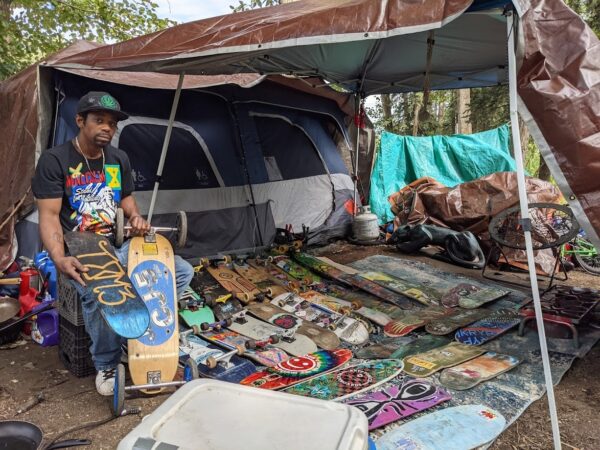
In a grove of birch and cottonwood trees between Anchorage’s Mountain View neighborhood and the Glenn Highway on a recent day, camp resident Cesar Carberry’s calloused fingers rubbed down the bottom of a skateboard deck with a hand sander.
It takes about an hour to get the old paint off before he draws and paints an original design on the bottom. He screwed in the trucks and attached the wheels. He sells the skateboards for $40 a piece. He calls his business A-1 Neva Boards.
“You’re never bored when, you know, when you’re on a skateboard. You always got something to do,” he said. “And it kept me out of a lot of trouble.”
Listen to this story:
Related:
Carberry doesn’t have a permanent place to stay. He said A1 Neva Boards is one of the reasons he doesn’t want to stay in a shelter, where the size of his personal belongings are limited to what he can fit in a plastic tote.
But in this large camp, the dozens of other campers have dozens of other reasons for not wanting to be in a congregate shelter, from claustrophobia to fear of catching COVID-19. Some want to be in neighborhoods close to their families and others just love the open air.
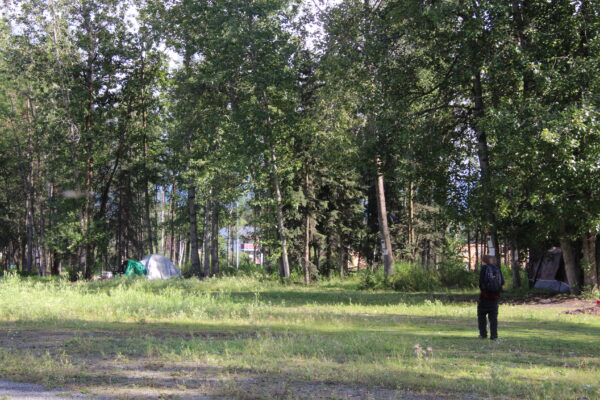
Scattered around Carberry’s spacious tent are buckets filled with spare skateboard parts, tools and a full-size ceramic statue of a panther. There’s no trash, other than some scrap metal, and his two dozen skateboards are lined up neatly in a tarp-covered awning outside his tent. But this isn’t how he wants his 8-year-old son, who lives elsewhere, to see him.
“He’ll ask me, ‘You’re going back to the tent?’ And I’m like, that’s not what I want,” he said. “I want, ‘You going back to your shop? Are you going back to your house?’”
Carberry’s tent, and the dozens of others in the area, were slated to be removed.
During the first week of August, the city came to the lot — which is used as a snow dump in the winter — and posted white paper signs on the trees. The signs gave the legally-required notice to the dozens of campers that they’re required to leave within 10 days. The city calls it “abatement,” though many campers refer to it as “eviction.”
Soon city employees planned to haul out hundreds of pounds of junk and trash from the abandoned sites. The abatement process costs the city hundreds of thousands of dollars each year, and it forces campers to spend hours packing up and moving their belongings to new campsites every few months or years.
RELATED: What happened to the Bronson shelter plan in Anchorage and what happens next? Here’s what we know.
“It’s just it’s … it’s getting old,” Carberry said.
The city says it has abated about 180 camps so far this year and hauled out 261 tons of trash, according to the city’s parks department. There’s no good estimate for how many campers are in the city at one time. Each year on a dark night in January, city workers try to count every tent, but it’s likely there are many more campers in the summer when the weather is milder.
In another tent near Carberry, 28-year-old Devon Felton had already started to pack his things up for the move. He’s pencil thin and his jeans sag below his waist. The Vancouver, Wash., native pulled out a camp chair and sat down for an interview.
“I moved down here because of some family struggles and I’ve moved away from here three, four times and something about Alaska just keeps bringing me back. I love music, dancing and cooking,” he said.
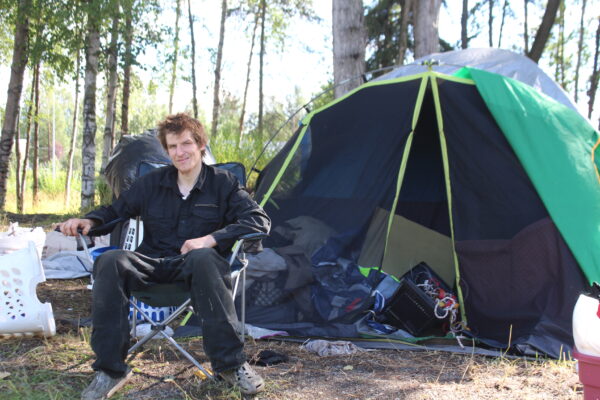
He competes in rap battles, and he melts down wires to make jewelry. But his talents don’t pay much. He said he’s looking for consistent work as a landscaper, but he hasn’t had luck lately.
“It’s kind of a stigma when you tell someone that’s hiring that you’re homeless, he said. “They — I don’t know how to describe it — they look at you differently.”
He said a shelter just isn’t for him, and he found a group at the camp that he trusts. They look out for one another, even if they’re forced to move to a new spot every few months.
“It’s more like a community, like a family out here than at the shelter,” he said.
A lot of the campers here say that the community is a big part of why they stay outside instead of in a shelter.
Some campers recently proposed that the city find a large, sanctioned campsite where they can offer limited services, like trash and bathrooms, to residents. Camper Allen Lavont Jefferson wrote the proposal as part of the Homeless Resource Advisory Council.
“As a solution-oriented community, we would do all the cleaning, bag up all the trash, take it and put it in a designated area where we could meet and greet other people who are having the same problem,” he said.
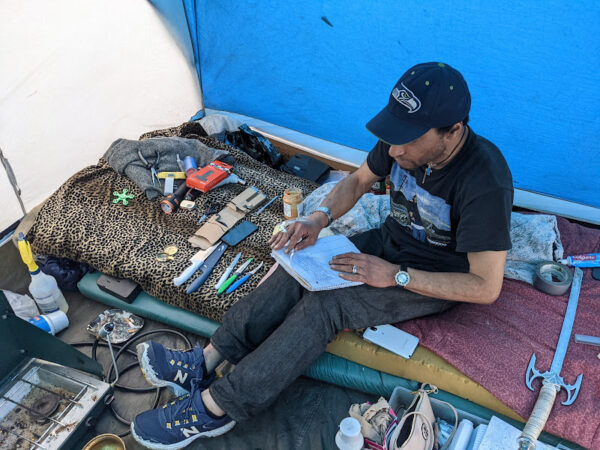
The idea hasn’t caught traction among policy makers, who want people in shelters where they have easier access to services like mental health care and housing support that will help them get out of homelessness.
But campers like Elshanikwa Durfee say there are disadvantages to shelters too.
“I’m an adult, I don’t think I should have an 11 o’clock curfew to be inside of the building,” she said. “Because this person is drunk, or this person has mental health issues, I’m supposed to just kind of be quiet and let them react or behave however they’d like to? I’m not really good with getting along with people.”
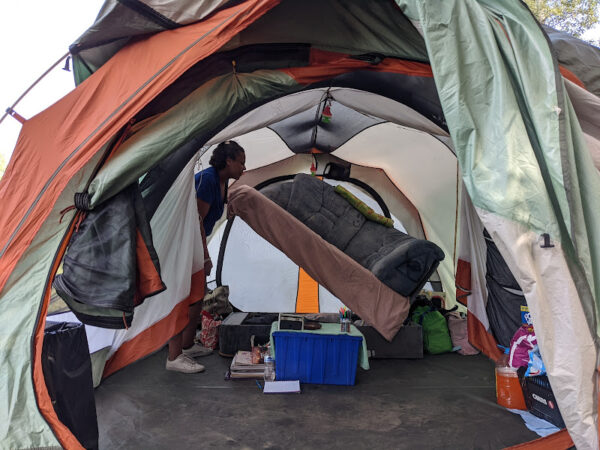
She said at the Mountain View snow dump, she can hide away in her tent if she starts to feel overwhelmed by crowds. And, she said, pointing to the leaves fluttering above her tent, it’s a beautiful way of living.
“In the fall, all these trees change all different colors around here and it’s just quiet enough to where at night, that highway sounds like an ocean,” she said.
She hoped, last week, to enjoy it for a few more days before moving on to a new campsite.
Lex Treinen is covering the state Legislature for Alaska Public Media. Reach him at ltreinen@gmail.com.





